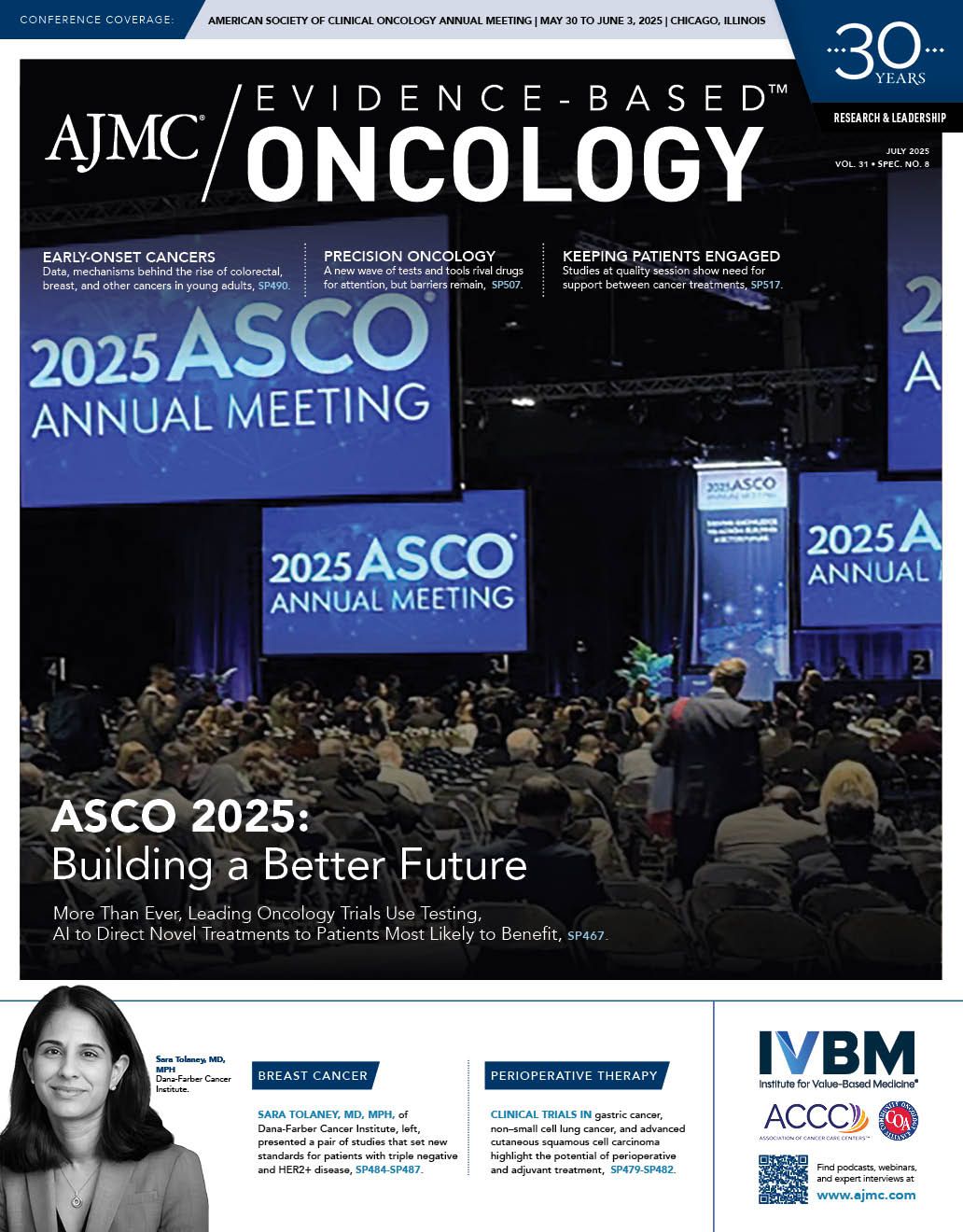- Center on Health Equity & Access
- Clinical
- Health Care Cost
- Health Care Delivery
- Insurance
- Policy
- Technology
- Value-Based Care
COCOON Shows How Prophylactic AE Management Boosts QOL When Treating NSCLC With Amivantamab Plus Lazertinib
The COCOON trial reveals that prophylactic treatment reduces dermatological adverse events in NSCLC patients, enhancing their quality of life during amivantamab therapy.
Cancer treatments work only if patients take them, and adverse events (AEs) are a top reason patients may not stick with a therapy. Thus, finding ways to manage AEs can be as important as discovering a new molecule if it means better outcomes.1
That’s why interim results from the phase 2 COCOON trial (NCT06120140) gained attention during the 2025 American Society of Clinical Oncology Annual Meeting.2 Dermatologic AEs are well documented among patients with non–small cell lung cancer (NSCLC) treated with intravenous (IV) amivantamab (Rybrevant; Johnson & Johnson), a bispecific antibody that targets EGFR and MET receptors. AEs can include an itchy rash that resembles acne, along with inflammation in the nail beds, affecting nail growth.
Alexander I. Spira, MD, PhD | Image: Virginia Cancer Specialists

The premise of COCOON is simple: If patients taking amivantamab are treated with a prophylactic regimen, will AEs be reduced? And will patients experience a better quality of life (QOL)?
The trial evaluated 138 patients newly diagnosed with advanced NSCLC being treated with amivantamab and lazertinib (Lazcluze; Johnson & Johnson), a third-generation tyrosine kinase inhibitor targeting EGFR.2 Data published in June 2024 showed this combination produced a 30% progression-free survival benefit when compared with osimertinib (Tagrisso; AstraZeneca).3 In COCOON, 68 patients received standard of care (SOC), which meant treating dermatologic AEs after they appeared. In the prophylactic arm, 70 patients were treated with oral doxycycline/minocycline, clindamycin 1% lotion on scalp, a daily wash of chlorhexidine 4% to hands and feet, and noncomedogenic ceramide-based moisturizer to body and face each day.2
Patients’ QOL was assessed every 2 weeks with a validated patient-reported outcomes instrument. The Skindex-16 questionnaire assessed the impact of skin conditions on QOL using 3 subscales (functioning, emotional, symptoms) and an average score on their experience of overall symptoms.
Results showed that differences between the 2 arms were seen early on; after a follow-up of at least 12 weeks, patients receiving the prophylactic dermatologic regimen had less severe AEs, with less impact on their QOL.2 Results showed the following:
- At cycle 3 day 15 (about 10 weeks), patients on the COCOON regimen had a lower average Skindex score than those receiving SOC (P = .02).
- At cycle 3 day 15, there was a 3-fold difference for COCOON vs SOC arms in patients reporting no symptoms on the Patient Global Impression of Severity for skin rash (21% vs 7%; P = .04) and skin condition (23% vs 7%; P = .02).
- There were also improvements in patients reporting no symptoms for nail infections (27% for COCOON vs 16% SOC; P = .13).2
The American Journal of Managed Care (AJMC) spoke with the study’s senior author, Alexander I. Spira, MD, PhD, who is CEO and clinical director, NEXT Oncology Virginia, and chair of the Research Executive Committee for The US Oncology Network.
This interview has been lightly edited.
AJMC: Can you describe the scope of the problem that skin and nail reactions present in patients being treated with amivantamab?
Spira: No. 1, it is one of these things that really affects quality of life, and No. 2, it affects the ability of patients to stay on these drugs for a while. You can argue that one is more important than the other, but they’re both equally important. It’s a very simple idea: giving people prophylactic treatments vs waiting for [AEs] to happen.
AJMC: How does the mechanism of prophylactic treatment work?
Spira: With the EGFR-targeted monoclonal antibody amivantamab, we know all these drugs have skin toxicity because EGFR is associated in the skin. So, what occurs is dryness, serious acne-like infections, and scalp issues. So, it’s really very simple. It’s antibiotics. We know antibiotics help with acne, both topical and oral medications, as well as just keeping the skin moist and keeping it clean—that’s really all that it is. It’s very basic stuff, but you really do have to be rigorous about it.
AJMC: Some of the drugs are used to treat acne in teenagers, correct?
Spira: That’s right. They’re all drugs we use all the time.
AJMC: Your data presented are from a follow-up of 12 weeks. Would we expect this regimen to work beyond that time frame?
Spira: We believe that if you made a difference in 12 weeks, [that] would make a difference for the long term. We’re not looking for survival—we’re looking for improvement of the rash and fewer [AEs].… So it’s a very simple question, and the patients who did the prophylaxis did better.
AJMC: Is there anything specific in the findings that stands out?
Spira: Obviously, we want to improve rash, and that’s already been reported. Here, we are following up with patient-reported outcomes and looking at, “Do we improve quality of life?” And the answer is, yes, we do improve quality of life.
AJMC: As you know, a subcutaneous version of amivantamab is on track to be approved shortly.4 What kind of difference would that present for patients?
Spira: It will make a big difference [in] time. No. 1, it will [reduce] time in the clinic, and No. 2, the infusions will go from many hours to minutes. So, it will help doctors and patients. But the real medical advance is that it gets rid of the infusion-related reactions, which could be severe and scary—sometimes incredibly severe. Some patients get very sick, and that incidence went down a lot as well. In the original study, there was even a hint of survival benefit with the [subcutaneous] formulation vs IV. It’s not clear that will pan out, but there was a hint. So, we’ve improved outcomes as well, but the real benefit is in infusion-related reactions and the time.
References
- Sacchi de Camargo Correia G, Pai T, Li S, et al. Immune-related adverse events in patients with lung cancer. Curr Oncol Rep. 2023;25(11):1259-1275. doi:10.1007/s11912-023-01462-w
- Feldman JL, Cho BC, Li W, et al. Dermatologic prophylaxis and impact on patient-reported outcomes in first-line EGFR-mutant advanced NSCLC treated with amivantamab plus lazertinib: results from the phase 2 COCOON trial. J Clin Oncol. 2025;43(suppl 16):8641. doi:10.1200/JCO.2025.43.16_suppl.8641
- Cho BC, Lu S, Felip E, et al; MARIPOSA Investigators. Amivantamab plus lazertinib in previously untreated EGFR-mutated advanced NSCLC. N Engl J Med. 2024;391(16):1486-1498. doi:10.1056/NEJMoa2403614
- Scott R. FDA issues complete response letter to subcutaneous amivantamab BLA in EGFR+ NSCLC. OncLive. December 17, 2024. Accessed June 20, 2025. https://www.onclive.com/view/fda-issues-complete-response-letter-to-subcutaneous-amivantamab-bla-in-egfr-nsclc

Oncology Onward: A Conversation With Dr Debra Patt of Texas Oncology
August 1st 2023Debra Patt, MD, PhD, MBA, joins hosts Emeline Aviki, MD, MBA, and Stephen Schleicher, MD, MBA, for episode 2 of our newest podcast, "Oncology Onward: Conversations With Innovators and Changemakers in Cancer Care."
Listen
Integrated Care for Chronic Conditions: A Randomized Care Management Trial
December 3rd 2025The authors sought to understand the differential impact of payer-led community-based care management approaches on stakeholder-oriented outcomes for publicly insured adults with multiple chronic conditions.
Read More
